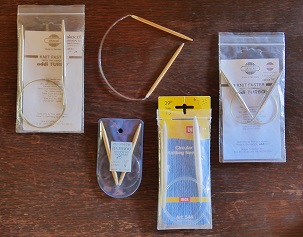While circular needles were designed to create spiraling tubes
 While circular needles were designed to create spiraling tubes of knitting, they can actually do it all. When the end of a row is reached, turn the needles as you would straight needles and you get a flat fabric. Dog ear a long circular, or use two circulars to mimic double pointed needles. Because they are so good at multitasking, a knitter can save money by only purchasing circular needles.
While circular needles were designed to create spiraling tubes of knitting, they can actually do it all. When the end of a row is reached, turn the needles as you would straight needles and you get a flat fabric. Dog ear a long circular, or use two circulars to mimic double pointed needles. Because they are so good at multitasking, a knitter can save money by only purchasing circular needles.One drawback to using circular needles is having to stop and push stitches over the join to the working end of the needle. Depending on the quality of the join between the needle point and the wire holding the two points together, the process of moving stitches over that join can be nearly painless to totally frustrating.
A second drawback is the wire itself. Any wire will behave when there are many stitches and rows holding the wire at bay. The problem is when there are few stitches or few rows, the wire may develop a mind of its own. Warming the wire can help. Wear it around your neck, warm in water (not the wood part!), or place in the sun are some options that may help a particularly curly wire.
When you knit in the round, you are actually spiraling and cre ating a tube. This is very evident where the ends of the cast on are joined. There are several options to eliminate this jog. One way is to cast on an extra stitch. This stitch is knitted together with the first stitch as the two ends are joined into a tube. A neater way is to work the first row flat generally by purling. With the second row, join the tube and knit away. You will have to sew this tiny one row seam with the handy attached yarn end. This little seam eliminates the jog perfectly.
The tube created by knitting in the round is rather barrel shaped. Great for socks but it can be rather unattractive in a sweater. One solution is to make a purl stitch where each side seam would normally occur. Two good things happen. The purl stitch softens the barrel shape and gives structure to the side seams. The single purl stitch folds in on itself and looks much like a regular seam. This folding action gives the knitter a hiding place when starting the next row. Because the spiraling is very evident in certain stitch patterns, this purl stitch hiding place is a most convenient solution to making that line disappear.

